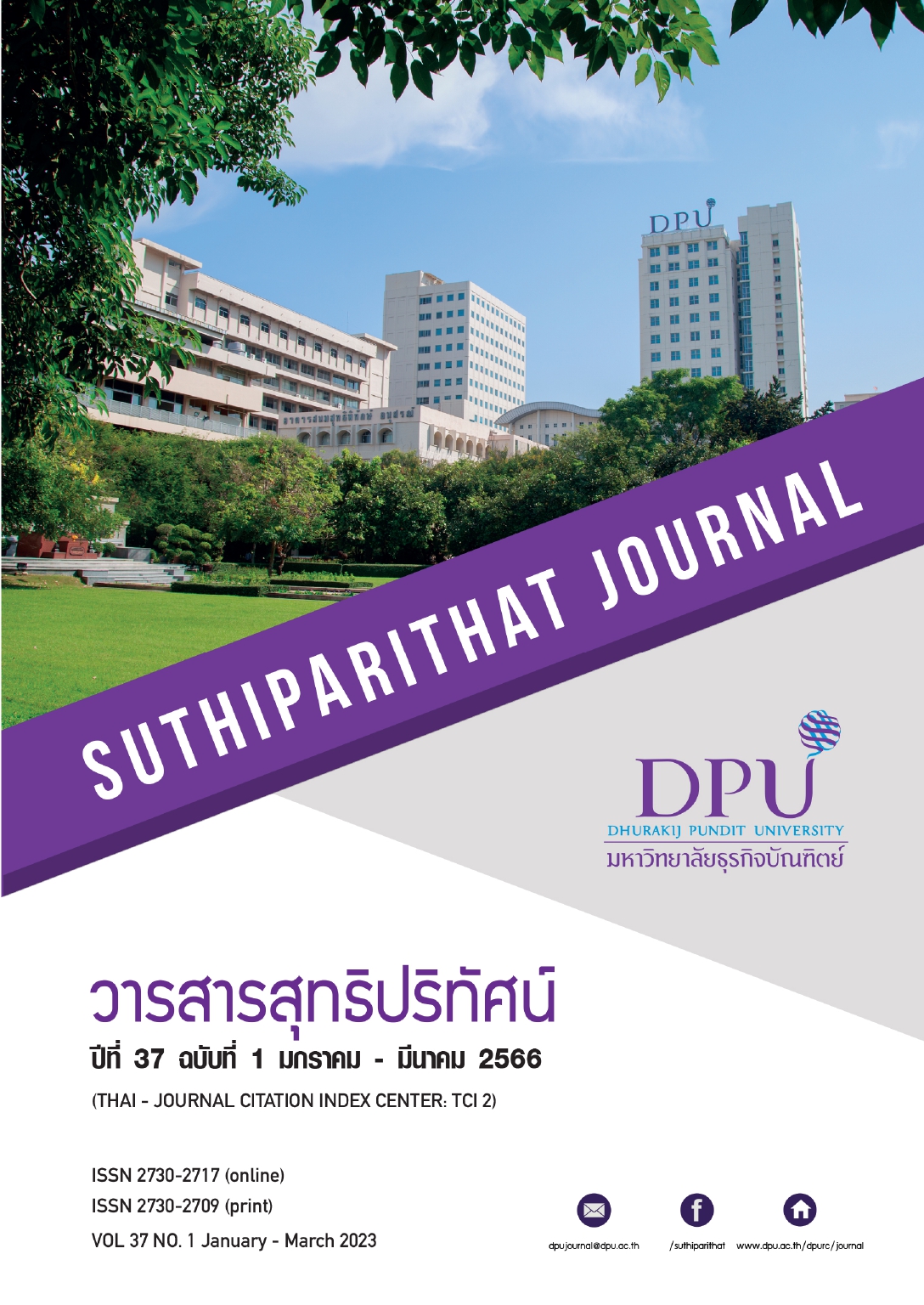อัตราส่วนทางการเงิน โครงสร้างคณะกรรมการ กับผลการดำเนินงานของบริษัทที่ จดทะเบียนในตลาดหลักทรัพย์แห่งประเทศไทย ดัชนี CLMV
คำสำคัญ:
อัตราส่วนทางการเงิน, โครงสร้างคณะกรรมการ, ตลาดหลักทรัพย์แห่งประเทศไทย, ดัชนี CLMVบทคัดย่อ
การวิจัยครั้งนี้มีจุดมุ่งหมายเพื่อศึกษาอัตราส่วนทางการเงิน โครงสร้างคณะกรรมการ กับผลการดำเนินงานของบริษัทที่จดทะเบียนในตลาดหลักทรัพย์แห่งประเทศไทย ดัชนี CLMV กลุ่มตัวอย่างที่ใช้ในการวิจัย คือ บริษัทที่จดทะเบียนในตลาดหลักทรัพย์แห่งประเทศไทย ดัชนี CLMV จำนวน 50 บริษัท โดยใช้ข้อมูลจากรายงานทางการเงิน รายงานประจำปี รวมทั้งรายงานผลการดำเนินงานในแบบ 56-1 และ 56-2 ย้อนหลัง 5 ปี จากปี 2560-2564 สถิติที่ใช้ในการวิเคราะห์ข้อมูล คือ สถิติเชิงพรรณนา ได้แก่ ค่าเฉลี่ย ค่าส่วนเบี่ยงเบนมาตรฐาน ค่าต่ำสุด ค่าสูงสุด สถิติเชิงอนุมาน ได้แก่ การวิเคราะห์สัมประสิทธิ์สหสัมพันธ์ และการวิเคราะห์การถดถอยพหุคูณ ผลการวิจัยพบว่า อัตราส่วนทุนหนุนเวียนต่อสินทรัพย์รวม (WA_TA) อัตราการหมุนเวียนของลูกหนี้ (AR_Turn) อัตราส่วนยอดขายต่อสินทรัพย์รวม (S_TA) อัตราส่วนสินทรัพย์ถาวรต่อสินทรัพย์รวม (FA_TA) อัตราส่วนหนี้สินต่อสินทรัพย์รวม (TL_TA) อัตราส่วนกระแสเงินสดต่อยอดขาย (CFO_SALE) สัดส่วนคณะกรรมการอิสระ (BOI) การควบรวมของประธานกรรมการอิสระและบริหาร (DUL) และความรู้บัญชีการเงินของคณะกรรมการบริษัท (BOD_EX) ส่งผลกระทบต่อผลการดำเนินงานซึ่งวัดจาก Tonbin’s Q ของบริษัทที่จดทะเบียนในตลาดหลักทรัพย์แห่งประเทศไทย ดัชนี CLMV ผลลัพธ์ที่ได้สามารถนำมาใช้เป็นโมเดลในการวางแผน และบริหารการดำเนินงานธุรกิจ รวมทั้งนักลงทุนสามารถนำไปใช้ในการวิเคราะห์เพื่อตัดสินใจลงทุนในตลาดหลักทรัพย์ ดัชนี CLMV ได้ในอนาคต
เอกสารอ้างอิง
กระทรวงพาณิชย์, กรมการค้าต่างประเทศ. (2564). การค้าของไทยกับกลุ่มประเทศ CLMV ปี 2564. https://www.bot.or.th/Thai/AboutBOT/InternationalCooperation/Doc_CLMVNews/Inter%20in%20Focus%207%20-%2011%20Feb%202022.pdf
ขวัญนภา เศิกศิริ, สมใจ บุญหมื่นไวย, และ ธนภณ วิมูลอาจ. (2561). อิทธิพลของอัตราส่วนทางการเงินต่อราคาตลาดหลักทรัพย์ของบริษัทจดทะเบียนในตลาดหลักทรัพย์แห่งประเทศไทย: กรณีศึกษากลุ่มอุตสาหกรรมบริการ. วารสารชุมชนวิจัย,12(2), 71–84. https://so04.tci-thaijo.org/index.php/NRRU/article/view/164578/119289
จักรกฤษณ์ มะโหฬาร. (2564). ปัจจัยที่ส่งผลต่ออัตราผลตอบแทนต่อส่วนของผู้ถือหุ้นของบริษัทที่จดทะเบียนในตลาดหลักทรัพย์แห่งประเทศไทย. วารสารธุรกิจปริทัศน์, 13(2), 96-107. https://so01.tci-thaijo.org/index.php/bahcuojs/article/view/192808/169123
จีราภรณ์ พงศ์พันธุ์พัฒนะ. (2558). กลไกการกํากับดูแล กิจการที่ดีและผลการดําเนินงานของกิจการ บริษัทจดทะเบียนในตลาดหลักทรัพย์แห่งประเทศไทย. วารสารวิทยาการจัดการสมัยใหม่, 8(1), 67-77.
ชุดาพร สอนภักดี, และ ทาริกา แย้มขะมัง. (2564). อัตราส่วนทางการเงินที่มีความสัมพันธ์กับราคาหลักทรัพย์ของบริษัทที่จดทะเบียนในตลาดหลักทรัพย์แห่งประเทศไทย. วารสารการจัดการและการพัฒนา มหาวิทยาลัยราชภัฏอุบลราชธานี, 8(1), 151-164. https://so06.tci-thaijo.org/index.php/JMDUBRU/article/view/249724/168950
ณัชพล จรูญพิพัฒน์กุล. (2564). ทำความรู้จักกับ CLMV โอกาสทางเศรษฐกิจที่น่าสนใจ. Focused and quick, 163, 1-8. https://www.bot.or.th/Thai/AboutBOT/InternationalCooperation/Doc_Articles/FAQ_CLMV.pdf
ณัฏฐ์ ณ ตะกั่วทุ่ง. (2559). ความสัมพันธ์ของอัตราส่วน ทางการเงินกับราคาหลักทรัพย์ในกลุ่มอุตสาหกรรม อาหารและเครื่องดื่มของตลาดหลักทรัพย์แห่งประเทศไทย [การค้นคว้าอิสระปริญญามหาบัณฑิต, มหาวิทยาลัยกรุงเทพ]. http://dspace.bu.ac.th/jspui/handle/123456789/2121
ณัฐพัชร์ นวลมณีฐิติ, พัทธนันท์ เพชรเชิดชู, และ ศิริเดช คำสุพรหม. (2563). อิทธิพลของการบริหารความเสี่ยงองค์กรที่มีต่อมูลค่ากิจการที่วัดโดยใช้ Tobin’s Q ของบริษัทที่จดทะเบียนในตลาดหลักทรัพย์แห่งประเทศไทย. วารสารสุทธิปริทัศน์, 34(111), 243-259. https://so05.tci-thaijo.org/index.php/DPUSuthiparithatJournal/article/view/244442/168100
ณัฐริณี ศิวะพรประสงค์, และ กัลยาภรณ์ ปานมะเริง. (2563). ความสัมพันธ์ระหว่างอัตราส่วนทางการเงินกับราคาหลักทรัพย์ของบริษัทจดทะเบียนในตลาดหลักทรัพย์แห่งประเทศไทย SET 100: กลุ่มอุตสาหกรรมอสังหาริมทรัพย์และก่อสร้าง. ใน การประชุมวิชาการนำเสนอผลงานวิจัยระดับชาติ ครั้งที่ 3 (น. 257-264). มหาวิทยาลัยราชภัฏสวนสุนันทา.
ณัฐวุฒิ ทรัพย์สมบัติ, ก้องภพ แสงทอง, ณัฐนรี ยาสะบู่, ณัฐพล ลัดดี, นิศานนท์ ชูแก้ว, และ ศิวกร พงษ์ศิริ. (2560). ความสัมพันธ์ระหว่างการกำกับดูแลกิจการกับมูลค่ากิจการของบริษัทในตลาดหลักทรัพย์แห่งประเทศไทย SET100. วารสารการจัดการมหาวิทยาลัยวลัยลักษณ์, 9(4), 1-14. https://so06.tci-thaijo.org/index.php/wms/article/view/245346/166279
ณิศดาภัทธิ์ ชะโลธร, และ ภูมิฐาน รังคกูลนุวัฒน์. (2564). ความสัมพันธ์ระหว่างกระแสเงินสดกับผลตอบแทนกำไรของบริษัทในตลาดหลักทรัพย์แห่งประเทศไทย กลุ่มเทคโนโลยีสารสนเทศและการสื่อสาร ปี พ.ศ. 2553-พ.ศ. 2562. ใน การประชุมวิชาการเสนอผลงานวิจัยระดับบัณฑิตศึกษาแห่งชาติ ครั้งที่ 22 (น. 774-784). มหาวิทยาลัยขอนแก่น.
ตลาดหลักทรัพย์แห่งประเทศไทย. (2564, 25 พฤษภาคม). ดัชนี SETCLMV. http://www.set.or.th/th/market/index/setclmv/overview
ทิพากร ศรีชัยธำรง, ชลกนก โฆษิตคณิน, และ นิกข์นิภา บุญช่วย. (2561). อิทธิพลของงบกระแสเงินสดต่อสภาพคล่องและความมั่งคั่งสูงสุดของธุรกิจกรณีศึกษา: กลุ่มสินค้าอุตสาหกรรมในตลาดหลักทรัพย์แห่งประเทศไทย. วารสารศิลปการจัดการ, 5(1), 87-102. http://research.bkkthon.ac.th/abstac/ab_12072564105058.pdf
วิภาดา ภาโนมัย, และ นงค์นิตย์ จันทร์จรัส. (2559). โครงสร้างคณะกรรมการบริหารกับผลการดำเนินงานของบริษัทที่จดทะเบียนกลุ่มธุรกิจอาหารและเครื่องดื่ม. วารสารการจัดการ มหาวิทยาลัยวลัยลักษณ์, 5(2), 44-55. https://so06.tci-thaijo.org/index.php/wms/article/view/57738/47805
Asiri, B. K., & Hameed, S. A. (2014). Financial ratios and firm’s value in the Bahrain Bourse. Research Journal of Finance and Accounting, 5(7), 1-9. https://core.ac.uk/reader/234629860
Beasley, M. S., & Salterio, S. (2001). The relationship between board characteristics and voluntary improvements in audit committee composition and experience. Contemporary Accounting Research, 18(4), 539-570. https://doi.org/10.1506/RM1J-A0YM-3VMV-TAMV
Beaver, W. H. (1996). Financial ratios as predictor of failure. Journal of Accounting Research, 4(3), 71-111. https://doi.org/10.2307/2490171
Bhandari, S. B., & Iyer, R. (2013). Predicting business failure using cash flow statement based measures. Managerial Finance, 39(7), 667-676. https://doi.org/10.1108/03074351311323455
Bowerman, B. L., & O’Connell, R. T. (1990). Linear statistical Models: An Applied Approach (2nd ed.). Duxbury.
Chancharat, N., Krishnamurti, C., & Tian, G. (2012). Board structure and survival of new economy IPO firms. Corporate Governance: An International Review, 20(2), 144-163. https://doi.org/10.1111/j.1467-8683.2011.00906.x
Christie, A. A., & Zimmerman, J. L. (1994). Efficient and opportunistic choices of accounting procedures: corporate control contests. The Accounting Review, 69(4), 539-566. https://www.jstor.org/stable/248431
Chung, K. H., & Pruitt, S. W. (1994). A simple approximation of Tobin’s Q. Financial Management, 23(3), 70-74. https://doi.org/10.2307/3665623
Daily, C. M., & Dalton, D. R. (1994). Corporate governance and the bankrupt firm: An empirical assessment. Strategic Management Journal, 15(8), 643-654. https://doi.org/10.1002/smj.4250150806
Fama, E. F., & Jensen, M. C. (1983). Separation of ownership and control. Journal of Law and Economics, 26, 301-325. https://doi.org/10.1086/467037
Garcia-Gallego, A., & Mures-Quintana, M. J. (2012). Business failure prediction models: Finding the connection between their results and the sampling method. Economic Computation and Economic Cybernetics Studies and Research, 3(3), 157-168.
Hashim, H. A., & Devi, S. (2008). Board Independence, CEO duality and accrual management: Malaysian evidence. Asian Journal of Business and Accounting, 1(1), 27-46. https://ajba.um.edu.my/index.php/AJBA/article/view/2184/499
Hayashi, F. (1982). Tobin’s Marginal Q and Average Q: A neoclassical interpretation. Econometrica, 50(1), 213-224. https://doi.org/10.2307/1912538
Hinkle, D. E. (1998). Applied statistics for the behavioral sciences. Houghton Mifflin.
Jensen, M. C. (1993). The modern industrial revolution, exit, and the failure of internal control systems. The Journal of Finance, 48(3), 831-880. https://doi.org/10.1111/j.1540-6261.1993.tb04022.x
Kaminski, K. A., Sterling Wetzel, T. S., & Guan, L. (2004). Can financial ratios detect fraudulent financial reporting?. Managerial Auditing Journal, 19(1), 15-28. https://doi.org/10.1108/02686900410509802
Kim, C. N., & McLeod, R. Jr. (1999). Expert, linear models, and nonlinear models of expert decision making in bankruptcy prediction: A lens model analysis. Journal of Management Information systems, 16(1), 189-206. https://doi.org/10.1080/07421222.1999.11518239
Lewellen, W. G., & Badrinath, S. G. (1997). On the measurement of Tobin’s Q. Journal of Financial Economics, 44(1), 77-122. https://doi.org/10.1016/S0304-405X(96)00013-X
Li, H., Sun, J., & Wu, J. (2010). Predicting business failure using classification and regression tree: An empirical comparison with popular classical statistical methods and top classification mining methods. Expert Systems with Applications, 37(8), 5895–5904. https://doi.org/10.1016/j.eswa.2010.02.016
Liou, F. (2008). Fraudulent financial reporting detection and business failure prediction models: A comparison. Managerial Auditing Journal, 23(7), 650-662. https://doi.org/10.1108/02686900810890625
Mohamad, N. E., & Saad, N. B. (2010). Working capital management: The effect of market valuation and profitability in Malaysia. International Journal of Business and Management, 5(11), 140-147.
Myers, R. H. (1990). Classical and modern regression with applications. PWS-Kent.
Nanarong, P. (2006). The relationship between ownership structure and the ability to earn accounting profit of listed companies in the stock exchange of Thailand. Journal of Management Science, 8(1), 1-15.
Ong, S., Choong Yap, V., & Khong, R. W. L. (2011). Corporate failure prediction: A study of public listed companies in Malaysia. Managerial Finance, 37(6), 553-564. https://doi.org/10.1108/03074351111134745
Persons, O. S. (1995). Using financial statement data to identify factors associated with fraudulent financial reporting. Journal of Applied Business Research, 11(3), 38-46. https://doi.org/10.19030/jabr.v11i3.5858
Pongpanpatana, J. (2015). Mechanism of good corporate governance and firm performance: An empirical evidence from Thai-Listed Firms. Journal of Management Science, 8(1), 83-95.
Sharma, P., & Chrisman, J. J. (2007). Toward a reconciliation of the definitional issues in the field of corporate entrepreneurship. Entrepreneurship Theory and Pratice, 23(3), 11-28. https://doi.org/10.1177/104225879902300302
Smith, C. W., & Stulz, R. M. (1985). The determinants of firms’ hedging policies. Journal of Financial and Quantitative analysis, 20(4), 391-405. https://doi.org/10.2307/2330757
Stewart, J. & Munro, L. (2007). The impact of audit committee existence and audit committee meeting frequency on the external audit: Perceptions of Australian auditors. International Journal of Auditing, 11(1), 51-69. https://doi.org/10.1111/j.1099-1123.2007.00356.x
Theodossiou, P., Kahya, E., Saidi, R., & Philippatos, G. (1996). Financial distress and corporate acquisitions: Further empirical evidence. Journal of Business Finance & Accounting, 23(5-6), 699-719. https://doi.org/10.1111/j.1468-5957.1996.tb01149.x
Vafeas, N. (2010). Audit committees, board, and the quality of reported earnings. Contemporary Accounting Research, 22(4), 1093-1122. https://doi.org/10.1506/1QYN-2RFQ-FKYX-XP84
ดาวน์โหลด
เผยแพร่แล้ว
เวอร์ชัน
- 2023-04-20 (2)
- 2023-03-30 (1)
รูปแบบการอ้างอิง
ฉบับ
ประเภทบทความ
สัญญาอนุญาต
ลิขสิทธิ์ (c) 2023 มหาวิทยาลัยธุรกิจบัณฑิตย์

อนุญาตภายใต้เงื่อนไข Creative Commons Attribution-NonCommercial-NoDerivatives 4.0 International License.
เนื้อหาและข้อมูลในบทความที่ลงตีพิมพ์ในวารสารสุทธิปริทัศน์ ถือเป็นข้อคิดเห็นและความรับผิดชอบของผู้เขียนบทความโดยตรงซึ่งกองบรรณาธิการวารสาร ไม่จำเป็นต้องเห็นด้วย หรือร่วมรับผิดชอบใด ๆ
บทความ ข้อมูล เนื้อหา รูปภาพ ฯลฯ ที่ได้รับการตีพิมพ์ในวารสารสุทธิปริทัศน์ ถือเป็นลิขสิทธิ์ของวารสารสุทธิปริทัศน์หากบุคคลหรือหน่วยงานใดต้องการนำทั้งหมดหรือส่วนหนึ่งส่วนใดไปเผยแพร่ต่อหรือเพื่อกระทำการใด ๆ จะต้องได้รับอนุญาตเป็นลายลักษณ์อักษรจากวารสารสุทธิปริทัศน์ก่อนเท่านั้น







